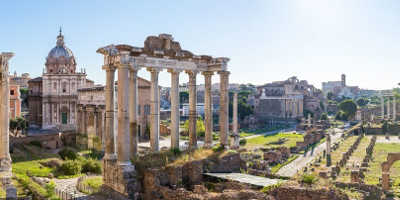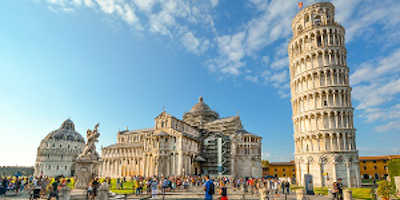Virtual Tour of the Colosseum and Roman Forum
Explore the ancient world of Rome without stepping out your front door with our virtual tour of the Colosseum and Roman Forum.
The Colosseum and Roman Forum are two of Rome’s most visited attractions. Every year, millions of travellers come walk through the commanding arch entrances to explore the world of Ancient Rome and imagine life here two thousand years ago under the Western Roman Empire. While both attractions are currently closed, that doesn’t mean we can’t discover the fascinating history and stories these two sites offer. So whether you are in your travel gear or your pyjamas, explore with us on our virtual tour of the Colosseum and Roman Forum.
-
Colosseum
Also known as the Flavian Amphitheatre after the dynasty responsible for its construction between 72 – 80 AD, the Colosseum is an iconic symbol Ancient Rome situated in the heart of the modern city. The huge amphitheatre was the stage for violet public spectacles including gladiatorial fights, battle re-enactments and executions. ‘
It could accommodate up to 80,000 spectators in seating arranged according to class with the best seats reserved for senators and exclusive boxes for the emperor. The spectators could be sheltered from the sun by awnings that were rolled out from the roof. Beneath the wooden stage was a series of tunnels and cages that housed slaves and animals to be released into the arena via trapdoors and pulleys.
After centuries of entertainment, the Colosseum fell out of use as rising costs and changing tastes meant it was no longer viable. During the Middle Ages, much of the Colosseum was damaged by natural disasters and looted for building materials. Other buildings and monuments around Rome including Palazzo Venezia and St Peters Basilica contain parts of the former amphitheatre. The Colosseum was neglected for centuries until the 1990s when restoration efforts took place to welcome tourists through its doors. It is now one of the world’s most visited attractions, accepting more than 7 million visitors a year.
-
Arch of Constantine
Exiting the Colosseum, to your left you will notice the imposing Arch of Constantine. The triumphal arch towered over the route taken by victorious military leaders when entering Rome. It was commissioned by the senate to commemorate ten years of Constantine rule and his victory at the Battle of Milvian Bridge.
Dedicated in 315 AD, the decorative reliefs illustrate victories by Roman emperors Trajan, Hadrian and Marcus Aurelius. Some sections of the sculptures were repurposed from previous monuments, with characters remodelled to resemble Constantine. Following the fall of the Roman Empire, the arch suffered from neglect until it was restored in the 15th century. Most recently, the arch has undergone extensive cleaning to restore it to its former glory.
-
Arch of Titus
Commissioned by Emperor Domitian shortly after his brother Titus’ death, the arch of Titus was constructed in 81 AD over the Via Sacra in Rome. The arch commemorates Titus and his father’s victory in the Jewish War in Judaea ten years earlier. The sculptures depict the victory procession celebrated in 71 AD which concluded with the fall of Jerusalem.
-
Palatine Hill
Following the Via Sacra and passing under the Arch of Titus, turn left and climb the hill to Palatino. This is where Romulus is said to have founded Rome after he murdered his brother. The hills with views over Roman Forum, Circus Maximus and the surrounding area became home to palaces and villas of the Roman elite. Nowadays you can explore the ruins including those from Domus Flavia (the Imperial Palace) and take in the amazing views.
-
Roman Forum
Travelling back down to the lowlands between Palatine and Capitoline Hills you will arrive at the Roman Forum. This area was once the centre of commercial, political and religious life in Ancient Rome. Wander amongst the ruins to admire important monuments including the House of Vestal Virgins, Temple of Saturn and the Senate (Curia).
Like much of Ancient Rome, the Roman Forum was neglected in the middle ages, as it was raided for materials and used for cattle grazing. Construction of new buildings and monuments often took place over the top of earlier ruins, creating layers of several centuries of history to be uncovered by archaeologists. Excavations began in 1803 and continue today to unearth fascinating relics from the past, giving us an insight into Ancient Roman life.
While this virtual tour may have offered you a taste of some of the delightful sights and stories of these ancient icons, nothing beats exploring in real life. We hope to see you in Rome soon for a tour in the flesh!
Related article: The Best Time to Visit Rome
















